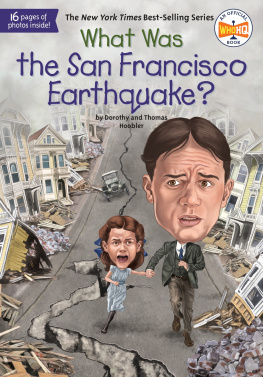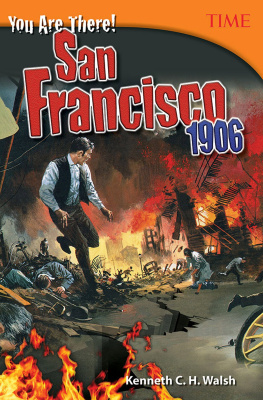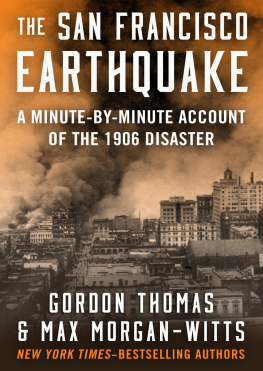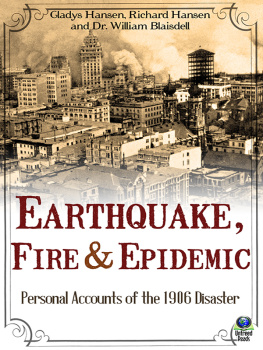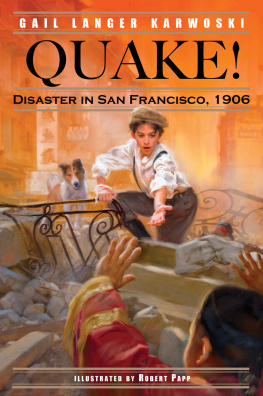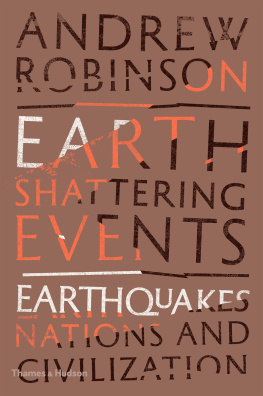
IMAGES
of America
1906 SAN FRANCISCO
EARTHQUAKE
ON THE COVER: The use of cars was instrumental in the aftermath of the quake and fires. Cars provided officials the ability to communicate with the military, which was scattered throughout the city as a means of providing security. They were also used for the distribution of supplies and provisions. This image shows a photographer capturing, in detail, the destructive force of the earthquake and fires.
IMAGES
of America
1906 SAN FRANCISCO
EARTHQUAKE
Richard Hansen and Gladys Hansen

Copyright 2013 by Richard Hansen and Gladys Hansen
ISBN 978-0-7385-9658-7
Published by Arcadia Publishing
Charleston, South Carolina
Library of Congress Control Number: 2012947056
For all general information, please contact Arcadia Publishing:
Telephone 843-853-2070
Fax 843-853-0044
E-mail
For customer service and orders:
Toll-Free 1-888-313-2665
Visit us on the Internet at www.arcadiapublishing.com
To my wife, Karen, who puts up with my history interests.
CONTENTS
We wish to thank the following people for their support and interest in the 1906 research: Diana Yee, for her support in helping to do research and handling email over 20 years; Dr. William Blaisdell, for opening our eyes to the medical problems of the disaster; and Kathleen Manning of Prints Old and Rare, who gave support and advice.
Lastly, we wish to thank all who have sent information on the 1906 disaster to our web site, the Museum of the City of San Francisco, at sfmuseum.org.
All images used in this book are from our own personal collection, which we have spent years cultivating.
The early morning of April 18, 1906, was not any different from the previous morning, or the morning before that. Fishermen were coming in with the previous evenings catch, and bakers were beginning their labors, as they had for the days and weeks before. That morning, it took all of 85 seconds to destroy the gentle stillness associated with the wee hours of a normal San Francisco morning.
At 5:12 a.m., a 25-second foreshock shook the city awake. The foreshock, which would equal about a 4.0 on todays Richter scale, was only a gentle rumbling compared to what followed. Approximately 30 seconds later, the ground shook with a violence no one thought possible. San Francisco was hit by an earthquake of unbelievable intensity, registering about an 8.3 on the Richter scale. The quake lasted about 60 seconds and threw the thriving metropolis of the early 1900s into a chaotic mix of tumbling buildings and horrible fires, ending the life its citizens had come to know. The quake was felt from Oregon to Los Angeles and as far inland as Nevada.
The quake caused structural damage to most of the buildings and roads in the city. Many of the brick buildings simply collapsed into mounds, trapping whoever was unlucky enough to be inside. However, it was not the earthquake that caused the most damage. The quake ignited numerous fires throughout the city, which continued to burn for days until there was simply no fuel left.
It is estimated that more than 30 fires broke out, quickly overwhelming the understaffed fire department. The fires burned for 490 city blocksapproximately 25,000 buildings. Ironically, many of the fires were set by the fire department themselves. Using dynamite, they attempted to create firebreaks by leveling certain building or structures that were in the path of the oncoming blaze. Having not received proper training in the use of dynamite, this decision turned disastrous rather quickly, with many of the dynamited buildings catching fire and adding to the destruction. They raged for three days and nights.
In an instant, the great city of San Francisco was reduced to rubble, with flames scorching anything and anyone in their path. The total estimated damage from the quake and the subsequent fires came to almost $500 million. However, the emotional toll was incalculable. What started as a quiet morning turned into a nightmare, lasting long after the earth settled and the last flames were extinguished.
The following is a May 14 report from the fire alarm operator, James C. Kelly, to Chief W.R. Hewitt of the Department of Electricity in regards to the fire alarm system on April 18:
Dear Sir:
In reply to your request under date of the 11th Inst. for full detail as to matters happening under my observation the morning of the Earthquake, I beg to say:
Shortly before sunrise, as I was standing at an east window of the Fire Alarm office [at 15 Brenham Place] looking toward the Hall of Justice, the earthquake began. I went at once to the clock to note the time and duration of the shock. The shock began at 5:13 plus 10 Secs. A. M., and I watched its duration at the clock for 19 seconds, when it became so severe, and there seemed such danger of the walls and ceilings of the building falling, that I ran to underneath the frame of one of the front windows as a place of greater safety;the relay Oper. having meanwhile taken refuge in the doorway between the operating room and the battery room. The vibrations still continued for some seconds as I remained at the window, and I saw meanwhile the southeast wall of the tower of the Hall of Justice fall; also part of the walls of a brick building near the corner of Washington Street and Brenham Place. Finally the shock ceased.
While yet the vibrations continued I had noted, by the running of the Registers on fire box signal circuits, that the lines on those circuits were open. Within a very few seconds after the shock ended I saw the smoke of an apparently large fire begin to rise from what I judged to be the vicinity of Market and Beale St.; (box 267). I at once went to key to strike out said box, (meanwhile calling to Relay Opr. to set up 267 on Repeater). No alarm came in for this fire, and be it noted that no alarms whatsoever came into the office after the commencement of the earthquake.
San Franciscans were skeptical about earthquake threats. The following essay, entitled, Are we in Danger from Earthquakes?, appeared in the San Francisco Real Estate Circular in April 1872:
No disastrous earthquake has visited San Francisco within the past hundred years, and the series of earthquakes which lately occurred in the southeastern corner of the State, four hundred mileson the edge of the great Interior Basin, and in a volcanic regionwere by no means so disastrous or severe as those which visited the Mississippi Valley in 1811, or those which are of frequent occurrence in New Zealand, Japan and many other countries. Nevertheless, the people of the Atlantic States look upon California as one of the most dangerous earthquake countries in the world. This is due to the infernal habit of exaggeration which characterizes Eastern newspaper letter-writers and newspaper editors. The New York papers published such sensational heads as these, lately: California Rocking from One End to the other! Californias Fearful Cataclysm! The Solid Earth Melting! etc., etc., while a few correspondents here supplemented and added to the lies and excitement. The truth, however, isjudging by an analogy and all the light that science has placed within our reachSan Francisco is in very little more danger of a disastrous earthquake than the Eastern States of being flooded by an overflow of the Atlantic Ocean. Some of the distant southern and southeastern counties are subject to heavy shocks, but there is little danger, even there, to those who reside in frame buildings.
Next page


